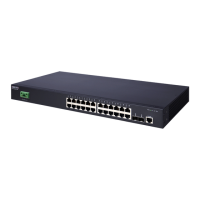Chapter 26
| CFM Commands
Defining CFM Structures
– 780 –
Default Setting
No maintenance domains are configured.
No MIPs are created for any MA in the specified domain.
Command Mode
Global Configuration
Command Usage
◆ A domain can only be configured with one name.
◆ Where domains are nested, an upper-level hierarchical domain must have a
higher maintenance level than the ones it encompasses. The higher to lower
level domain types commonly include entities such as customer, service
provider, and operator.
◆ More than one domain can be configured at the same maintenance level, but a
single domain can only be configured with one maintenance level.
◆ If MEPs or MAs are configured for a domain using the ethernet cfm mep
command or ma index name command, they must first be removed before you
can remove the domain.
◆ Maintenance domains are designed to provide a transparent method of
verifying and resolving connectivity problems for end-to-end connections. By
default, these connections run between the domain service access points
(DSAPs) within each MA defined for a domain, and are manually configured
using the ethernet cfm mep command.
In contrast, MIPs are interconnection points that make up all possible paths
between the DSAPs within an MA. MIPs are automatically generated by the
CFM protocol when the mip-creation option in this command is set to “default”
or “explicit,” and the MIP creation state machine is invoked (as defined in IEEE
802.1ag). The default option allows MIPs to be created for all interconnection
points within an MA, regardless of the domain’s level in the maintenance
hierarchy (e.g., customer, provider, or operator). While the explicit option only
generates MIPs within an MA if its associated domain is not at the bottom of the
maintenance hierarchy. This option is used to hide the structure of network at
the lowest domain level.
The diagnostic functions provided by CFM can be used to detect connectivity
failures between any pair of MEPs in an MA. Using MIPs allows these failures to
be isolated to smaller segments of the network.
Allowing the CFM to generate MIPs exposes more of the network structure to
users at higher domain levels, but can speed up the process of fault detection
and recovery. This trade-off should be carefully considered when designing a
CFM maintenance structure.
Also note that while MEPs are active agents which can initiate consistency
check messages (CCMs), transmit loop back or link trace messages, and
maintain the local CCM database. MIPs, on the other hand are passive agents

